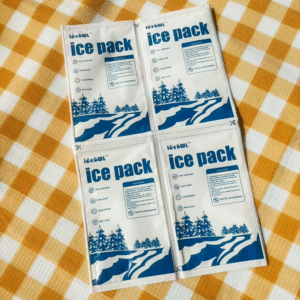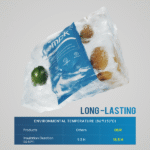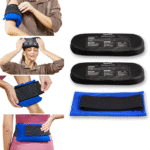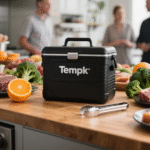Sac à glace sec instantané: Comment garder les expéditions froides?
Introduction: Si vous expédiez des denrées périssantes, un sac à glace sec instantané helps you hold safe temps without leaks or hazmat hassles. Use it to keep frozen items solid or maintain 2–8 °C for vaccines and biologics. Chemical “snap” packs cool fast for 2–4 hours; reusable gel/PCM bricks in insulated boxes can extend cold for 24–72 hours. You get cleaner packaging, fewer spoilage claims, and predictable delivery quality.
-
What is an instant dry ice pack? How it differs from gel ice and solid CO₂
-
How does it work in shipping? Activation, placement, and packing density
-
Which type should you choose? Chemical vs. reusable gel/PCM vs. vraie glace sèche
-
How to pack for 2–8 °C or frozen lanes? Pratique, step‑by‑step workflows
-
Quoi de neuf 2025? Surveillance plus intelligente, des délais plus longs, and greener materials
What is an instant dry ice pack—and which type fits your lane?
Réponse courte: An instant dry ice pack delivers rapid, mess‑free cold using either a single‑use endothermic reaction (“snap” packs) or a reusable gel/phase‑change material (PCM) that you pre‑freeze. It mimics the cold performance people expect from dry ice—without CO₂ vapor, pooling water, or hazmat limits. Typical cold windows: 2–4 h for chemical packs; 24–72 h for reusable gel/PCM in insulated shippers.
Pourquoi ça compte pour toi: You can right‑size cold power to the route. A snap pack is perfect for emergency replenishment or short courier hops. A gel/PCM pack is ideal for overnight to 2‑day lanes when paired with a tested shipper. For ultra‑cold or special effects, vraie glace sèche (−78,5 ° C) is still an option—but it adds hazmat handling and ventilation needs you may not want in e‑commerce workflows.
Which instant dry ice pack type should you choose?
Détails:
-
Single‑use chemical (snap) paquet: Squeeze to break an inner pouch. An endothermic reaction absorbs heat fast. Great for first‑mile hand‑offs, clinic runs, or last‑mile cushions.
-
Reusable gel/PCM brick: Soak (if required), then freeze. Holds narrow setpoints (Par exemple, 2–8 ° C, −20 ° C). Faire le ménage, réutilisable, and shipping‑friendly.
-
True dry ice pod/bricks: Ultra‑cold mass for frozen and specialty lanes; requires ventilation and compliance steps.
| Use Case Fit | Snap Pack | Gel/PCM Brick | Ce que cela signifie pour vous |
|---|---|---|---|
| Activation & Prep | Instantané, no freezer | Pre‑freeze before use | Choose snap for ad‑hoc; gel/PCM for planned lanes |
| Cooling Window | ~2–4 h | 24–72h (in an insulated box) | Match window to transit + buffer time |
| Moisture/Leaks | Sec, pas d'eau de fonte | Sec, pas d'eau de fonte | Clean labels, fewer returns |
| Safety/Compliance | No CO₂ vapor | No CO₂ vapor | Simpler air/ground shipping than dry ice |
Practical tips that save shipments
-
Short courier hops: Utiliser snap packs above and below the items; fill voids to eliminate warm air pockets.
-
Overnight food or meal kits: Pré-Chill à l'expéditeur, alors sandwich goods between gel/PCM bricks; add a thin barrier to prevent cold shock on produce.
-
Biologics at 2–8 °C: Choose a +5 °C PCM setpoint, place a enregistreur de données at product level, and isolate vials from direct contact using a sleeve.
Cas réel: A West Coast meal‑kit brand switched to reusable gel packs. A weather delay added ~24 hours, but boxes still arrived at 3 °C and customer complaints fell by ~30% over the next quarter—without adding dry ice fees.
How do you pack and handle an instant dry ice pack safely?
Étapes de base: Check seals, pre‑freeze (for gel/PCM), activate (for snap), envelopper, lieu, and vent. Always use gloves, avoid airtight containers, and keep a breathable path for any gas expansion. Plan placement above and below the payload for even cold and stability.
Pourquoi ça marche: Cold sinks and radiates from mass. By surrounding the payload and removing headspace, you slow heat gain. With gel/PCM, you also avoid humidity spikes that can damage cartons, étiquettes, and inserts. For true dry ice, never seal in airtight vessels—pressure can build and damage packaging.
Quick “Pack Count” estimator (copy‑paste mini tool)
Use this simple rule of thumb when you can’t run a full OQ/PQ:
-
Conseil: Pre‑chill the shipper and product to cut required packs by 10–20%.
-
Conseil: Placer un logger in the warmest spot (center of mass) to verify.
| Packing Step | Ce qu'il faut faire | Pourquoi ça aide | Pour toi |
|---|---|---|---|
| Condition préalable | Freeze PCM packs fully | Maximizes latent heat | Longer hold time |
| Remplissage de vide | Block air gaps | Reduces convection | More stable temps |
| Top loading | Put packs above goods | Cold sinks naturally | Fewer excursions |
Field‑proven pro tips
-
Clinic runs: Use a +5 °C PCM, thin bubble wrap around vials, and a palm‑size logger.
-
Desserts congelés: Ajouter un thin rigid barrier between pack and pastries to avoid surface freeze‑burn.
-
Returns: Designate “return‑ready” packs with QR labels so customers can refreeze and reuse.
Instant dry ice pack vs. regular ice or gel: what changes in outcomes?
Fin de compte: Instant dry ice packs hold colder, cleaner, plus long than loose ice and simplify shipping compared with dry ice. You gain consistent setpoints without leaks, plus freedom from CO₂ handling rules—especially valuable for air shipments and residential delivery.
| Fonctionnalité | Sac à glace sec instantané | Regular Gel/Ice | Ce que cela signifie pour vous |
|---|---|---|---|
| Température | Sub‑zero capable; tuned PCMs | ~0 °C plateau | Frozen or 2–8 °C lanes with precision |
| Durée | 2–4 h (snap); 24–72h (gel / pcm) | Heures; gel < 24 H | Fewer excursions on delays |
| Mess/Leaks | Sec, no runoff | Meltwater risk | Clean packaging, intact labels |
| Patrie | No CO₂ vapor | N / A | Easier compliance than dry ice |
2025 instant dry ice pack developments and trends
Instantané de la tendance: Dans 2025, shippers are standardizing narrow‑band PCMs for 2–8 °C and −20 °C, embedding Bluetooth/GPS loggers in last‑mile boxes, et adoption reusable pack programs to cut waste. Ultra‑thin bricks now freeze faster between turns, and longer‑hold formulations push beyond 72 hours in tested shippers—reducing re‑icing stops.
Dernier en un coup d'œil
-
Eco‑forward packs: Reusable shells and lower‑plastic designs reduce disposal loads.
-
Smart visibility: Box‑level sensors trigger alerts before a true excursion.
-
Performance tuning: PCMs targeted at +5 °C for biologics reduce cold shock risk.
Perspicacité du marché: Demand for grocery delivery and temperature‑controlled pharma continues to expand. Brands that validate pack‑outs et instrument shipments see fewer refunds and higher repeat purchase rates—because customers receive products at the right temperature the first time.
Questions fréquemment posées
Q1: Is an instant dry ice pack real dry ice?
Non. It replicates cold performance without solid CO₂, so there’s no CO₂ vapor and fewer restrictions. Use true dry ice only when you need −78.5 °C.
Q2: How long does an instant dry ice pack stay cold?
Snap packs hold ~2–4 h; reusable gel/PCM bricks in insulated shippers can hold 24–72 h. Validate with a logger for your lane.
Q3: Do I need to freeze it first?
Freeze gel/PCM packs fully before use. Snap packs activate on demand by squeezing a pouch.
Q4: Are they food‑ and pharma‑safe?
Oui. They’re sealed, non toxique, and widely used for meal kits and vaccines; keep a barrier between packs and unpackaged food.
Q5: How many packs should I use?
Estimate with the quick formula above, then confirm with test shipments for your lane and shipper size.
Résumé et étapes suivantes
Ce qui compte le plus: Utiliser le sac à glace sec instantané qui correspond à votre voie, pre‑condition correctly, entourer la charge utile, Retirer les lacunes de l'air, and log temperatures. You’ll reduce excursions, protect margins, and deliver a better unboxing experience.
Faites ça maintenant:
-
Map your lane times and setpoints (2–8 °C or frozen).
-
Choose snap vs. gel/PCM and size your pack‑out with the estimator.
-
Run a validation with a logger and tweak placement.
-
Standardize SOPs and track spoilage KPIs.
CTA: Need a tested pack‑out? Talk to Tempk’s cold chain team to match packs, expéditeur, and lane—then scale with confidence.
À propos du tempk
We build practical cold chain solutions that balance performance, coût, et conformité. Tempk instant dry ice packs are laboratory‑validated to maintain stable temperatures, sont réutilisables, and support 2–8 °C and frozen lanes. Our quality program includes third‑party certifications and a CNAS‑backed lab, and we hold multiple patents supporting long‑hold, leak‑free performance.
























